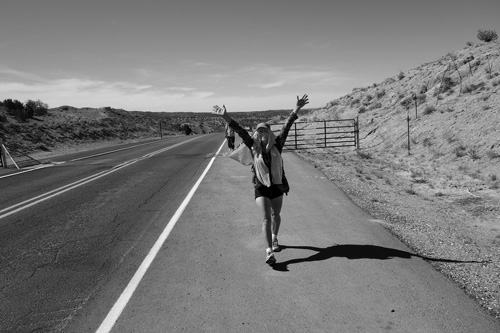News
Saving a planet, one step at a time
Pair from Berkshires join cross-country trek for climate-change action
By ALEX ELVIN
Contributing writer
WILLIAMSTOWN, Mass.
 Shira Wohlberg has walked more than 1,000 miles since March, when she set out from Los Angeles as part of a coast-to-coast march aimed at spurring action to combat climate change.
Shira Wohlberg has walked more than 1,000 miles since March, when she set out from Los Angeles as part of a coast-to-coast march aimed at spurring action to combat climate change.
By late May, the group had made its way through New Mexico and was heading north into Colorado.
Covering about 15 miles a day, the Great March for Climate Action is scheduled to arrive in Washington, D.C., on Nov. 1, just in time for the midterm elections. The 40 or so marchers are meeting people in communities along the way in hopes of building a national consensus on the need for an aggressive, sustained response to climate change.
More than 1,000 people are expected to participate over the course of the march, although many will join for just a few days or weeks.
Wohlberg, a dancer and massage therapist from Williamstown, said in a telephone interview from New Mexico that the decision to set aside several months of her life without knowing how it would turn out required a leap of faith.
“But there was no question,” she said. “This is what I believe in. I want to live in a community, and I love being outside, and it was just no question that I would do this. Of course I would do this.”
She began preparing last fall by buying a new pair of sneakers for $5 at the annual A Better Chance clothing sale in Williamstown.
“They are pretty much shot,” she said on May 23 as she paused near Taos, N.M. “I’m going to make it through New Mexico, and then I’m going to have to retire them, which is sort of thrilling because we’ve walked over 1,000 miles now.”
In every destination so far, she said, the marchers have been welcomed by local officials, the leaders of Native American tribes, and by many ordinary citizens who share their concerns. In many cases, local families have hosted the marchers in their homes or on their farms, and tribal communities have shared their traditions.
Anthony Pisano, a musician from North Adams, Mass., and a longtime friend of Wohlberg, joined the march for about 10 days in May.
“It’s been an amazing experience,” he said. “From the first day, I was wishing I could do the whole march right through to Washington, D.C.”
During Pisano’s time on the march, he performed at rallies and other public events with the Climate Justice Band, which he described as “just a random group of people – whoever happens to be playing at the time.”
The truck that carries the marchers’ camping gear also carries guitars, mandolins, percussion instruments, a fiddle and an accordion.
When they’re at home, Pisano and Wohlberg perform as the comedy duo Ms. Wicker and Mr. Tony Elbow at farmers markets and craft fairs around the Berkshires. Some new material they developed on the road may end up in their regular repertoire, Pisano said.
Making connections
Wohlberg said that in addition to the sense of community that has developed among the marchers, she appreciates the chance to help people across the country make contact with each other and with other communities that are concerned about the effects of climate change.
“As we go through, it becomes obvious that there are a huge number of people who are concerned – who are radically concerned – about what’s happening, and who are affected by it,” she said. “But it’s all different walks of life.”
In Albuquerque, N.M., for example, citizens and advocacy groups are pressuring the local utility PNM Resources to use renewable energy, rather than fossil fuels or nuclear power, to replace two coal-burning plants that it plans to retire. The climate marchers took part in a May 15 rally hosted by the Sierra Club, 350.org and other groups at the company’s headquarters.
The entire southwest is increasingly affected by drought, Wohlberg said. She pointed out that nuclear power uses huge amounts of water, contributing to the depletion of local aquifers.
In June, the march will cross the proposed route of the Keystone XL pipeline in Nebraska. Several campaigns are under way to block the project, which would bring heavy tar-sands oil from Alberta, Canada, to the Gulf Coast for refinement.
In April, the marchers held a series of vigils and other events in Arizona to show their solidarity with the Cowboy-Indian Alliance, a group of farmers, ranchers and tribal communities along the pipeline route. The Arizona events took place in the days leading up to the alliance’s April 22 protest in Washington urging President Obama to reject the pipeline.
Echoes of Occupy movement
Many of the climate marchers’ strategies are decided by consensus, and the group’s operating style is similar in some ways to that of the Occupy Wall Street movement in 2011. Some of the marchers were involved in that movement, Wohlberg said.
“But we are more focused, in a way, and we’re mobile, which is quite different,” she added. “And there is less direct action at this point.”
The group is still working on a strategy for when it arrives in Washington, and it has been working regularly to develop guidelines for the use of alcohol and for the number of vehicles that should be allowed to support the marchers, Wohlberg said.
Reaching consensus is often a long and frustrating process, she said, because each of the participants has slightly different goals for the march.
“It’s pretty fascinating, because we’ve had challenges agreeing on what we want our actions to be and what we’re willing to do individually,” she said.
One of her new friends is an arborist from Iowa who describes himself as a pragmatist. He supports a carbon tax, above all else. Another is a farmer from Kentucky who is concerned about mountaintop removal, a method of coal mining that permanently alters the landscape.
But despite having different priorities, the marchers’ experience of walking together all day for weeks on end has only strengthened their friendship, Wohlberg said.
“They’re my buds,” she said. “We’re just so tight from doing this day after day together.”
The landscape of the Southwest has also offered the marchers some poetic moments.
“Whenever we can, we walk into the sunrise, and it’s so quiet in the morning before the cars get out, and we can hear the birds waking,” Wohlberg said. “Often we’ve been on these huge mesas, and you see the sun rising over the edge of the mesa.”
Cash needs and compromises
Many of the marchers plan to walk all the way to Washington, while others join for just a short time. For all of them, part of the challenge is being able to raise enough money to keep going.
Wohlberg plans to return to the Berkshires in June to work for two months before rejoining the march in Iowa in August.
She said donations can be made to individual marchers through the fundraising Web site crowdrise.com, or they can be sent directly to the march’s headquarters in Iowa.
Participating costs about $20 a day for a part-time marcher. Part of the expense includes a 20-foot box truck that’s used to transport the marchers’ gear. Another vehicle carries four composting toilets, and another carries a portable charging station for cell phones and computers.
It’s not a “super-awesome sustainable lifestyle,” Wohlberg said, but she added that the group uses renewable energy sources whenever possible. The charging station, for example, is powered by solar panels, and a 6,500-watt wind power generator donated by a company in Iowa powers various electrical devices.
One benefit of the vehicles is that they allow the marchers to focus on the experience of walking, which Wohlberg sees as a priority.
“It’s being in these environments and moving at a human speed through them, rather than at a machine speed, so that you can really see the changes,” she said. “You can really appreciate the details. And this is largely what we’re walking for – because the planet is so incredibly beautiful and so diverse and so rich.
“It’s not just humans doing their thing here,” she added with a laugh. “There is a lot else going on here.”
She said she enjoys connecting with the physical act of walking, which has become something of a meditation.
“It’s this simple action and these simple steps, and if you keep at it you get somewhere,” she said. “So it’s a metaphor for the whole movement.”
Wohlberg said she doesn’t know whether her efforts will make a difference.
“But you have to at least try, and at least do you what your heart and your feet tell you.”

